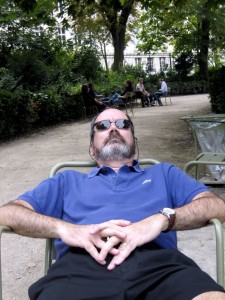Ideas and Free Throws
Assume, for a moment, that I’m your manager. I call you into my office one day and say, “You’re doing pretty good work … but you’re going to have to get better at shooting free throws on the basketball court. If you want a promotion this year, you’ll need to make at least 75% of your free throws.”
What would you do? Assuming that you don’t resign on the spot, you would probably get a basketball, go to the free throw line, and start practicing free throws (also known as foul shots). Like most skills, you would probably find that your accuracy improves with practice. You might also hire a coach or watch some training videos, but the bottom line is practice, practice, practice.
Now, let’s change the scenario. I call you into my office and say, “You’re doing pretty good work … but you’re going to have to get better at creating ideas. If you want a promotion this year, you’ll need to increased the number of good ideas you generate by at least 75%.”
Now what? Well … I’d suggest that you start practicing the art of creating good ideas. In fact, I’d suggest that it’s not very different from practicing the art of shooting free throws.
But shooting free throws and creating ideas seem to be very different processes. Here’s how they feel:
- Shooting free throws – you get a basketball, you walk to the line – 15 feet from the basket – and you launch the ball into the air. You’re conscious of every action. You recognize that you’re the cause and a flying basketball is the result.
- Creating ideas – nothing happens … then, while you’re walking down the street, minding your own business – poof! – a good idea pops into mind. You have no sense of agency. Instead of feeling like the cause, you feel like the effect.
The two activities seem very different but, actually, they’re not. In both cases, you’re doing the work. With free throws, you readily recognize what you’re doing. With ideas, you don’t. Free throws happen in your conscious mind, also known as System 2. New ideas, on the other hand, happen below the level of consciousness, in System 1. When System 1 works up an idea, it pops it into System 2 and you become aware of it.
We understand how to practice something in System 2 – we’re aware of our activity. But how do we practice in System 1? How can we practice something that we’re not aware of?
We think of our mind as controlling our body. But, as Amy Cuddy has pointed out, our bodily activities also influence our mental states. If we make ourselves big, we grow more confident. If we smile, our mood brightens.
So how do we use our bodies to teach our brains to have good ideas? First, we need to observe ourselves. What were you doing the last time you had a good idea? I’ve noticed that most of my good ideas pop into my head when I’m out for a walk. When I’m stuck on a difficult problem, I recognize that I need a good idea. I quit what I’m doing and go for a walk. Oftentimes, it works – my System 1 generates an idea and pops it into System 2.
In my critical thinking classes, I ask my students to raise their hands if they have ever in their lives had a good idea. All hands go up. Everybody has the ability to create good ideas. The question is practice.
Then I ask my students what they were doing the last time they had a good idea. The list includes: out for a walk, driving, riding in a car, bus, or train (but not an airplane), taking a shower, drifting off to sleep, and bicycling.
I also ask them what activities don’t generate good ideas. The list includes: when they’re stressed, highly focused, multitasking, overly tired, overly busy, or sitting in meetings.
So how do we practice the art of having good ideas? By doing more of those activities that generate good ideas (and fewer of those that don’t). The most productive activities – like walking – seem to occupy part of our attention while leaving much of our brainpower free to wander somewhat aimlessly. Our bodily activity influences and stimulates our System 1. The result is often a good idea.
Is that perfectly clear? Good. I’m going for a walk.
How Long Does It Take (To Have A Good Idea)?

Developing a slow hunch.
Friends often ask me how long it takes to write one of my web articles. I can frame the question narrowly or broadly. In the narrow frame, the answer might be 90 minutes or so. In the broad frame, it might be 30 years or so. Talk about a slow hunch.
I’ll illustrate with my most recent article: Hate, Happiness, Imagination. As with many things – especially innovations – the article is a mashup of several different sources and concepts. Let’s track them in chronological order.
The first idea came to me through Graham Greene’s brilliant novel, The Power and the Glory. The novel includes a lovely quote: “Hate is the failure of imagination”. Greene wrote the novel in 1940, so the idea is now at least 75 years old (or perhaps older since Greene seems to echo previous authors).
I read the novel when Suellen and I lived in Guanajuato, Mexico in 1980. The quote about hate and imagination struck me and has stuck with me ever since. So, I’ve been gestating the idea for 35 years. I would occasionally mention it to friends but, otherwise, I didn’t do much with it.
In 2005, David Foster Wallace gave his famous commencement speech at Kenyon College. He stressed that, all too often, we fail to imagine what life is like for other people. If we did use our imagination more fully, we would empathize more, and our lives would be richer and fuller. First, we have to recognize that we can make a choice — that we don’t have to operate on our egocentric default setting. Second, we actually have to make the choice.
I didn’t know about Wallace’s speech until I started teaching critical thinking. As I looked for sources, I came across a video of the (abridged) speech and used it several times in my class. I first stumbled across it in 2012.
I didn’t do much with the Kenyon College speech until a few weeks ago. Frankly, I had forgotten about it. Then one of my students discovered it and asked me to show it to the class. That led to a very healthy discussion during which I connected what Wallace said to what Greene wrote.
Bingo! I made the connection between the two ideas. Why did it take me so long? Probably because I was just thinking about it. Thinking is fine but I don’t think that merely thinking creates many new ideas. The give-and-take of the class discussion stimulated me to make new connections. The diversity of opinions helped me open up new connections rather than merely deepening old connections.
Still, I didn’t have a complete thought. Then Suellen read me a paragraph from a review of the new biography of Saul Bellow. The review mentioned Bellow’s belief that imagination is “eternal naïveté”. When I realized what he meant by that, it dawned on me that it completed the thought. Greene connected to Wallace connected to Bellow.
What can we learn from this? First, this little story illustrates Steven Johnson’s idea of the “slow hunch”. Many good ideas – and most innovations – result from mashing up existing ideas. Unfortunately, we don’t get those ideas simultaneously. We may get one in 1980, another in 2012, and another last month. The trick is to remember the first one long enough to couple it with the second one. (Writing a blog helps).
The other point is that the pure act of thinking is (often) not enough. We need to kick ideas around with other people. Diversity counts. I’m lucky that I can kick ideas around with my students. And with Suellen. If not for them, I wouldn’t be nearly as interesting as I am.
So, how long does it take me to have a good idea? About 35 years.
